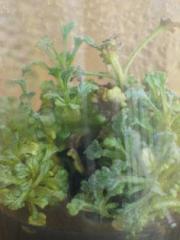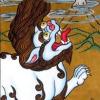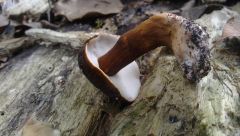Search the Community
Showing results for tags 'mycology'.
Found 25 results
-
Hi all.... like many of you im sure, I journey to some very beautiful and magic spots throughout the winter and get some great pics every year, so I thought I would share some with the community this year and at the same time make a commitment to brush up on my mycology and become a little more familiar with the folk im seeing during my travels with a little help from you all of course Ive been using the big ol web for identification to this point... but I intend on purchasing a book to take out field with me... I thought id ask for some suggestions for good Australian Id handbooks you guys are fond of before i go picking one up... would be greatly appreciated The season has been off to a slightly slower start than last but I managed to get some nice shots for the first short trek of the season.... all pine today but will be out in the native flora soon enough Im yet to do any deep work with the Amanita but I admire their vibrant nature and deep history... Gymnopolus. I have no idea what these are but they are huge.. haha. Mycena Genus? Armillaria? Not sure Some funky friends Chloropyllum? someone told me these are edible? Galerinas? Any help and advice on a good handbook would be appreciated... Cheers! ~Blessings.
- 4 replies
-
- 10
-

-
- beauty
- natureventuringintoitself
-
(and 2 more)
Tagged with:
-
Hi guys, I'm looking for a large pressure cooker, ~21L, to use for mycology. Im currently a bit limited on funds, so can not afford a brand new one, so if anyone had one lying around not being used and is thinking of getting rid of it, maybe we could strike up a deal? Located in Melbourne
-
Here are 2 discord channels Shaman Australis unofficial discord server https://discord.gg/UYaH6QT TripTeam https://discord.gg/PUvEpH6 Despite the name is all mushroom discussion, again, edibles and actives, supposedly created by willymyco, theres a lot of users but most are beginners unlike in fungus amongus. the servers share about 60% of the same users. This server though features a fairly stocked "show and tell" channel with now thousands of grow pictures. In tripteam, experimental methods are more tolerated than on shroomery and fungus amongus, deviation from the teks and such, but accuracy of information is still very much moderated. For those unaware, discord is like IRC but you can upload photos like in Facebook or skype, and also everything is saved up to a point i think, so you can always check back on stuff. In my opinion its way better than IRC. It also features voice channels, and soon will apparently have features for live streaming or screen sharing (it was originally built for gaming).
-
Was browsing through ebay and found these... 6x Pre-Sterilized BRF Jars -$65 (FREE POSTAGE) https://www.ebay.com.au/itm/332536472366?ssPageName=STRK:MESELX:IT&_trksid=p3984.m1558.l2649 12x Pre-Sterilized BRF Jars - $110 (FREE POSTAGE) https://www.ebay.com.au/itm/332536475182?ssPageName=STRK:MESELX:IT&_trksid=p3984.m1558.l2649
-
Just thought I'd let you know: I have had a 100% sterile success rate with the peroxide agar kitchen tek, both with the cooked method ( no autoclaving ) and the autoclaved method. Methods and comparison below Dispensing and media transfer was done under absolutely not sterile conditions, in order to see if the tek could be replicated anywhere ( those of you who know my kitchen can stop laughing ). I was a tad sloppy with my transfer tek as well to see what would happen Reporting it here because sometimes the signal/noise ratio can be a little loud elsewhere Batch 1- autoclaved + 6ml/L 3% H2O2 Chinese sauce containers were autoclaved in a bag for 20 min 100ml liquid MEA autoclaved for 20 min, consisting of the following 20g/L light malt extract 0.1g/L garden lime 0.1g/L potassium phosphate dibasic 15g/L gelcarin ( 20g/L agar works just as well ) Media was not subject to a pH test Post autoclave the media was allowed to cool and just above setting point 6ml/L 3% H2O2 was added. Media was swirled heavily so that the inner surfaces of the bottle were fully coated Dispensed immediately into sauce containers *on the kitchen bench* in the open air Lids were placed lightly over the containers and 1hr later the plates were completely sealed after inoculation with various species Batch 2- cooked 1hr + 6ml/L 3% H2O2 Chinese sauce containers were autoclaved in a bag for 20 min 100ml liquid MEA cooked for 1hr by placing media container in an open saucepan. Media container lids were left loose. Water came up the the media level- bottles weren't more than 3/4 immersed. Cooked at a slow boil for 1hr 20g/L light malt extract 0.1g/L garden lime 0.1g/L potassium phosphate dibasic 15g/L gelcarin ( 20g/L agar works just as well ) Media was not subject to a pH test Post autoclave the media was allowed to cool and just above setting point 6ml/L 3% H2O2 was added. Media was swirled heavily so that the inner surfaces of the bottle were fully coated Dispensed immediately into sauce containers *on the kitchen bench* in the open air Lids were placed lightly over the containers and 1hr later the plates were completely sealed after inoculation with various species Sterile ( non-peroxide MEA ) library cultures were opened and haphazardly used ( left open for much of the inoculation process ) to inoculate the plates above using a scalpel blade which was only cleaned and flamed between species The following species were placed in the centre of the agar of each container Reishi ( Ganoderma lucida ) Blue Oyster ( Pleurotus spp ) Lion's mane ( Hericium erinaceus ) Elm Oyster ( Hypsizgus ulmanarius ) Plates were sealed with Austraseal and incubated in the dark at 22C 2 plates from the cooked group and 2 plates from the autoclaved group were left uninoculated as controls to check for contamination during dispensing By my judgement it was all a bit haphazard and I didn't believe it would work. Even a contam rate of 10% per batch would have been acceptable At +1 week there is no contamination, anywhere, and growth is good for the Reishi and Elm Oyster. Still waiting on the Blue Oyster and Lion's Mane, but plenty of time yet- those parent cultures could have been a little old- I have storage/ library cultures and can reinoculate from them easily at +3 weeks If you are thinking about the peroxide tek for agar- give it a go. I've only made it sound complex cos I wanted to write it all up so you know I took all the steps. I now pronounce this part of the tek piss easy Edited very fast, because I am an idiot and forgot to put the decimal point in
-

Biosynthesis of The Psychoactive Drug Psilocybin
small_rabbit posted a topic in Pharmacology, Chemistry & Medicine
http://cen.acs.org/articles/95/web/2017/08/Magic-mushroomenzyme-mystery-solved.html Does the biosynthesis have the potential to increase psilocybin based medical research? -

Need psylicobe species prints/syringes for mycology assignment
Thisartismurder posted a topic in Mycology
I am in need of various psylicobe species prints/syringes for a mycology assignment. Low on funds help would be much appreciated thank you guys- 6 replies
-
- mushrooms
- magicmushrooms
-
(and 2 more)
Tagged with:
-
I'm isolating some local woodloving species onto agar and Trichoderma contam is a constant hassle with one of them. Trouble is the little buggers don't show up as discernable until they sporulate. And the mycelia I am working with is slow to start. What are your best options for working against Tricoderma spp on agar? I couldn't find anything specific on it. My best options so far are Serial dilution- a huge pain in the arse, because Trich is sporulating once it's visible, so the spores go into solution, and there are gazillions of them. Plus a good serial dilution run takes heeeeeeeaps of containers. Over a month. Minimum a hundred. Subculturing ahead- taking only the tiniest fragment of the leading edge, culturing it on, repeat Cardboard slopes haven't worked, as I'm uncertain of this species' ability to grow on cardboard. Still waiting at +10 days to see signs of mycelia. And I've seen Trich grow on cardboard heaps of times. The mycelia would have to grow much faster than the Trich to outrun it and I don't think that's going to happen Is there an agar type media selective against Trichoderma I could try?
- 9 replies
-
- contamination
- mycology
-
(and 1 more)
Tagged with:
-
Hi there folks, I'm testing the waters to see if anyone here has any spare canning jars they have laying around that they're not using that they want to get rid of. It's for mycology purposes. I'm happy to pay postage of course, and could even throw some short (20-30cm) Psycho0 tip cuttings your way too cheers
-
Exhibition From Botanical Illustrations to Research: Watercolours from the University of Melbourne Herbarium. 27 March to 28 June 2015 Plus some great looking Fungi lectures. All on Tuesdays for those of you who have the time. http://library.unimelb.edu.au/botanicalillustrations Thanks to Torsten for posting on the Facebook site.
-
Hi, I am a novice mycologist trying to find a couple of Psilocybe cubensis spore prints of any strain for microscopy and was hoping someone might be able to help me. Cheers
-
-
- 1
-

-
- bolete
- identification
-
(and 2 more)
Tagged with:
-
Hi all, I am a budding mycologist, seeking various spores for microscopy. Species i am interested in studying are: Panaeolus Cyanescens Mexican Dutch Kings I am after two prints of each. Thanks Guys.
- 1 reply
-
- microscopy
- panaeolus cyanescens
-
(and 2 more)
Tagged with:
-
Like it says in the title... Seeking clean slant or plate of Trametes versicolor that has been confirmed by fruiting and is ready to send. Will pay. Dammit I knew I shoulda got one isolated from here back when it was raining enough to make mushrooms :D
-
A bloke from Lismore gave me some boletes he described as Slippery Jacks yesterday. No confirm ID yet, and I'm not going to bother really, he's a lifelong forager and has been eating them from this patch for years. I'm satisfied they're edible Have done a lot of searching, and I remember reading the other day someone has managed to cultivate bolete-type mushrooms in beds or bags without associating them with a living tree. It was a recent tek, but for the life of me I can't find it, and it could be just my bad memory Anyone know of or has tried successful cultivation of boletes? I want to put this one on some wood pellet agar and/ or PDA + chloramphenicol for spawn, but if it's not a goer til a tek is perfected I won't take it further
-
This is gorgeous. Well written and beautifully illustrated. Local. And free. Fits nicely on portable devices Whoever funded this really got their money's worth A guide to common fungi of the Hunter-Central Rivers region http://hunter.lls.nsw.gov.au/__data/assets/pdf_file/0009/516807/guide-to-common-fungi-hcr.pdf
-
Help, what do I do? Who do I troll? Where do I go for my fungi porn??? SOMEBODY SHOW ME A MUSHROOM!
-
http://botit.botany.wisc.edu/toms_fungi/poster.html I found the Quotes for outrageous requests portion quite amusing.
-
hello all I am relatively new to this forum, well the posting side anyways, I'm a very interested in mycology and am wanting to know if anyone has any prints laying around they could spare? I am currently looking at each strain of psilocybe cubensis spore prints to see what the differences are if there is any, I currently have Brazilian cubensis, Tasmanian cubensis, a random print I got from finding some cubs in my local town, and Ecuadorean cubensis, I'm looking to get a good collection together so I can look at these under I microscope and take note on all the differences and research each a bit, when I'm done with these prints I will be giving them away to someone else looking to do the same thing, so if anyone have some spare prints they could give me it would be greatly appreciated, thanks
-
A long time ago I was a party to a convo about creating new strains of edibles via hyphal mating Most of the discussion was way over my head and still is, but the tek was ghetto and the results potentially identifiable without much equipment, no sequencing etc The tek was to culture two separate species on individual plates, each containing the same media Subculture two small sections of each species about 2cm apart onto a single plate Where they joined up, wait for sectoring to occur, and subculture each sector Fruit, and check results for morphological or environmentally distinct growing patterns Anyone done this? How viable a tek does it sound? How genetically distinct can the species be, for example a Pleurotus x Lion's Mane- would they be too far apart to hybridise? It sounds like fun, and easily quantifiable for macro level results ( ie, I'm not lookin for tiny changes, measurable only by sequencing, I'm looking for variations in fruiting shape ).
-

Cute fringe-y gilled thing, but what is it? IMAGE HEAVY
Darklight posted a question in Fungus Identification
OMG I found this cute fringed mushroom after yesterdy's rain It captured my imagination because of the entirely entertaining fringe it sports. Yesterday it looked like this ( not my pic ) https://secure.flickr.com/photos/borninborneo/7360712092/ But today the fringe or tufts were fully formed and pointing upwards- they weren't ragged edges of the broken cap, they were properly differentiated Here are the collection details: Found growing solitary on 30/5/2013 after rain, cap fully opened at 31/5 Approx GPS co-ordinates: -28.596731,153.097572 Grown on what appears to be leaf litter at a treeline in a cow paddock so unsure of substrate Cap- 150mm light/mid brown with raised fringe edge kinda like a parasol. Really. Not broken, but actually fringed! Really distinctive ring, kinda blobby or knobbly like Calendula seed, stained mildly yellow Stem about 100mm Gills blue/grey Cap broke off during transport and no staining observed Spores appear to be blue grey, no pics as yet Didn't have a camera with me so I didn't get any pics in situ I whacked some stem mycelium on an MEA + chloramphenicol plate I had sitting round, but I may have over-enthusiastically sterilised it, if it is interesting I may try to grow it on from the spore print Pics so far- links are to thumbnails, full pics in Gallery here:- 16 replies
-
- 1
-

-
I've had a few requests lately in-person for help and advice with sterile techniques- usually related to mycology, but also with regard to plant tissue culture It's hard to teach this online, and a lot dispiriting watching so many people burn out over the years trying to learn these teks in isolation I'm thinking about running a Sterile Tek for Mycology workshop to be run at Koda Phytorium in Byron Bay around early June. This will be a 2 day workshop of approx 5 hours a day with a lunch break in the middle I'd love some feedback on the course outline below. What would people like to see? What is redundant? Would you attend if you were in the area? Does it sound interesting for n00bs? Sterile Tek for Mycology Location: Koda Phytorium, Byron Bay Date: Mid June 2013, ( TBA ) 2 days Cost: About $350 per person ( but TBA, it's equipment intensive ), this includes your own take-home perspex tunnel and some hardware The proceeds of the workshop ( all the course fees minus equipment expenses ) will be donated to the Australian Ethnobotanical Association http://www.shaman-australis.com/forum/index.php?showtopic=34208 Limit: 4 people Aim: This workshop provides good practical grounding for culturing and growing gourmet edible and medicinal mushrooms at your home or community group. It is aimed at beginners and enthusiasts We'll be doing practical sessions with four woodloving species ( primary decomposers ): Oyster mushroom ( Pleurotus spp ), Shitake ( Lentinula edodes ). Shimeji ( Hypsizygus tessellatus ) and Reishi ( Ganoderma lucida ) This will be a small, practice-based, lab-centred workshop, covering theory and some practice of sterile tek, and some semi-sterile teks like hydrogen peroxide, shiitake newspaper logs and Pleurotus straw bales You don't need any experience with mycology to attend this workshop. You should be over 18, though we can waive that for people who can show maturity and commitment or have a parent or guardian who will be responsible for you and undertaking the course on the same day. This short practical course is extensive but not exhaustive- we'll cover the basic teks and theory but there are always new teks coming online. If you have some myco experience and would like to attend, we really welcome your input as long as you understand that you may be one of the more advanced students in the class Topics we'll cover: Biology and growth of edible and medicinal species. Ecology. Safety. Sterilisation and aseptic theory and practice. Inoculation and growth on solid and liquid media. Contamination and contam patterns. Spawn and dowel culture and handling. Research. Maintaining your culture library. Record keeping. Storage, and drying. We'll make some shiitake or reishi newspaper logs and a couple of Pleurotus straw bales. You'll take away some culture slants of your own. and a few extra copies we'll supply you with, a reishi or shiitake newspaper log, your own perspex tunnel and hopefully a head full of knowledge All workshop profits ( basically your course fee minus what I pay for the perspex tunnels and supplies ) will go to the Australian Ethnobotanical Association You will need to wear covered shoes. For best results and your own safety please keep long hair tied back during prac sessions. Bring a hat and something to drink for the outdoor sessions. Please make your own food, drink and accommodation arrangements The techniques you learn at this workshop can also be applied to plant tissue culture, and we may run workshops on that in future, however practicing these teks using your perspex tunnel after the myco workshop will significantly increase any benefit you get from a plant tissue culture workshop
-

Filter patch bags with injection ports? Anyone got a few spare?
Darklight posted a topic in Mycology
I'm running a demo on inculating spawn bags for some people who are looking to do myco work with groups who don't have lab access ( mostly overseas ). These people have a long, successful, established track record with working with communities to provide sustainable food supplies and they're looking at expanding that concept with myco products in their food forests. I'm figuring that the best way to do this could be to work with myco syringes, providing that there are no import restrictions for either myco or syringes in the places where they run workshops. Apparently most of these places have pressure cookers, so sterilising spawn won't be a problem as long as we can organise a suitable substrate that they can reliably access ( kitty litter for woodlovers, wild bird seed... we'e still not sure... that's next ) Grain bags can then be used to drill/ inoculate logs or newspaper rolls These looked interesting: http://unicornbags.com/store/product_info.php/cPath/26/products_id/40 5" x 4" x 18" filter patch with silicon injection port But I don't need a thousand of them. I need a dozen to run a proof of concept demo for them just to see how it will roll and how easy it is to teach. Does anyone have a spare dozen filter patch bags with injection ports ( pref of that size ) they can post me? Demo is being run gratis, but happy to pay for the bags.













